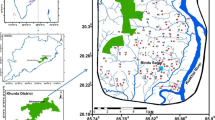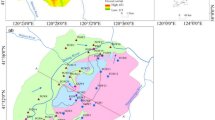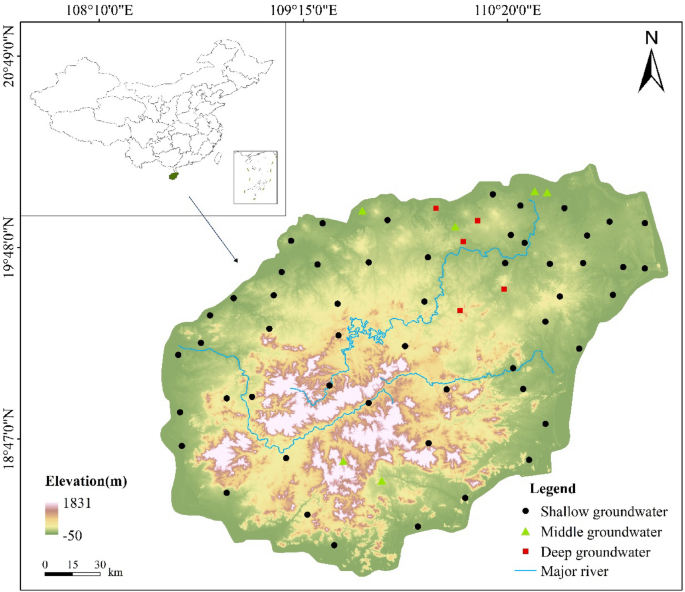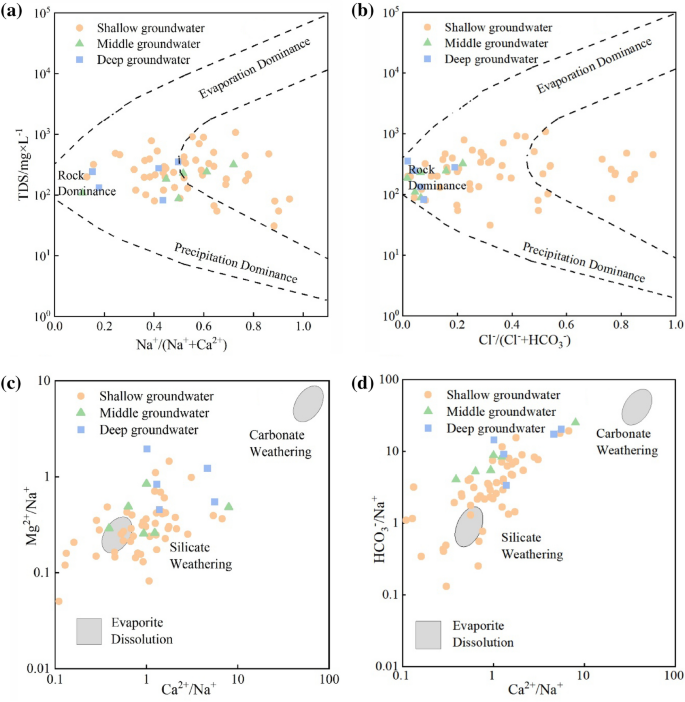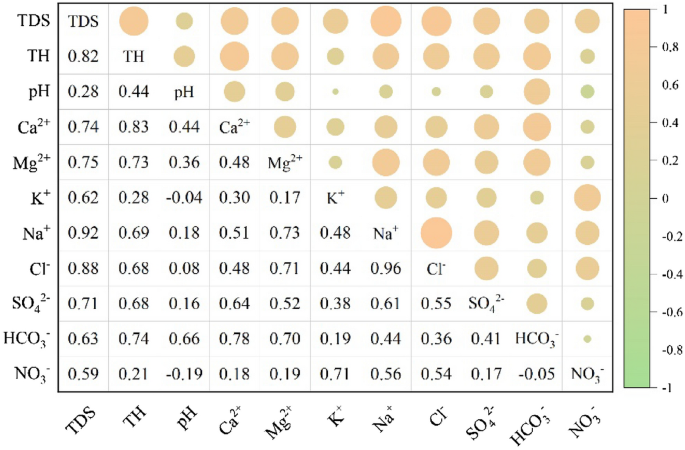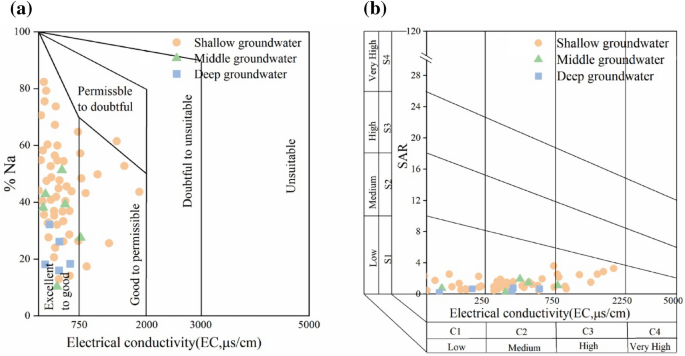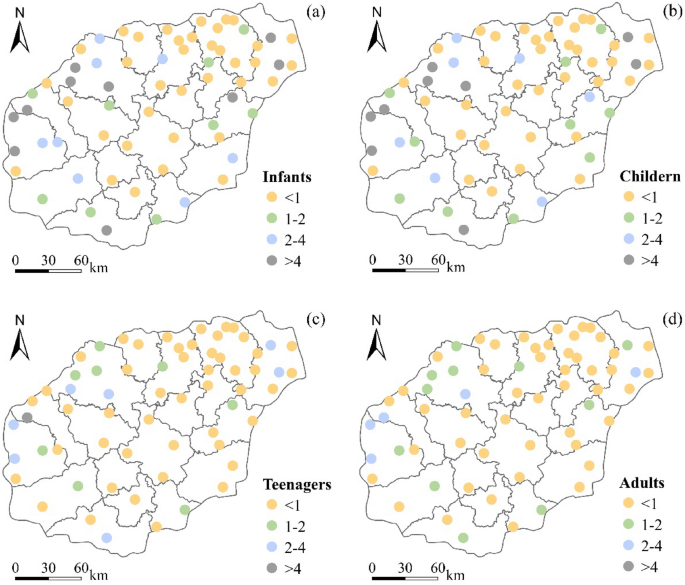Abstract
Groundwater is an important source of water for human sustenance. The determination of groundwater quality at island sites is an urgent priority in China, but there are lacking systematic reports relating to them. Here, 63 groups of groundwater samples were collected and analyzed of Hainan Island. The groundwater in the study area is weakly alkaline, mainly comprising hard and soft freshwater. The predominant anions and cations are HCO3−, and Ca2+ and Na+, respectively, and the main water chemistry types are HCO3–Cl–Na and HCO3–Cl–Na–Ca. The chemical evolution of groundwater is mainly affected by water–rock interactions, cation exchange, and human activity. The groundwater is mostly of high quality and, in most areas, is suitable for drinking and irrigation. Contrastingly, the water quality in the west of the island is relatively poor. The spatial distribution of the risk coefficient (HQ) is consistent with the spatial variation in the NO3− concentrations in the groundwater. Notably, there are unacceptable health risks for different groups of people, with infants having the greatest level of impact, followed by children, teenagers, and adults. This study provides a valuable reference for the development and utilization of groundwater resources, as well as the improvement of aquatic ecological conditions on Hainan Island and other island areas worldwide.
Similar content being viewed by others
Introduction
Groundwater is an important source of water for consumption, irrigation, and industrial use1,2,3,4. However, the improvement in people’s living standards and the degree of industrialization has resulted in a perpetual increase in the demand for water resources5,6,7, consequently leading to the over-exploitation of global groundwater resources, deterioration in water quality, and worsening of water security problems8,9,10,11. In particularly, groundwater resources face severe challenges, especially in island areas with more fragile natural ecosystems12,13,14. Most of the island areas have low rainfall, large evaporation, serious water and soil loss, and relatively lack of surface water resources. Therefore, the exploitation and utilization of groundwater is extremely important for the production and life of residents. The island groundwater system is an independent circulating system with limited supply sources. If water quality pollution is caused by natural factors and human activities, it may cause irreversible losses.
The chemical composition of groundwater is the result of its long-term interactions with the surrounding environment15. During groundwater formation and migration, physical and chemical interactions occur with the surrounding media, which affect the chemical composition of the water16,17. Simultaneously, groundwater is increasingly being affected by human factors18,19. Harmful substances produced by humans may enter groundwater, and the resulting pollution, which is spread via groundwater flows, can penetrate deep into the ground. In particular, NO3− produced by industrial production, agricultural activities and domestic sewage will enter shallow or even deep groundwater with rainwater or surface water, affecting the water quality and hydrochemical evolution process20. At present, nitrate pollution has become one of the major pollutants in the global groundwater and has caused potential health risks to residents21,22. The water quality index (WQI) simplifies the complex water quality index into a single value, which can be used to evaluate the water quality more intuitively and effectively23. At present, it has been widely used in the evaluation of drinking and irrigation water, and even innovatively used by some scholars to evaluate the suitability for industrial use. Nsabimana et al. and Li et al. used a new industrial water quality index (Ind WQI) model to determine the overall industrial water quality24. According to the determination of the main influencing factors in water quality assessments, the health risk assessment model and the assessment standard provided by the U.S. Environmental Protection Agency (USEPA) can be used to further assess risks to human health25.
Hainan Island is China’s second largest island, with one of the largest special economic zones and free trade ports, serving as the country’s major development strategy. Due to its location advantages and policy support, Hainan Island has undergone rapid modernization and the establishment of numerous industrial and agricultural parks. This rapid economic development has also increased pressure on residential water supplies and caused a series of ecological and environmental issues, including pollution, soil salinization, and seawater intrusion26,27. However, current research on groundwater on Hainan Island remains focused on hydro-chemical exploration, with a lack of comprehensive research on water quality evaluation and human health risk.
To address this research gap, the main goals of this study were to (1) analyze the groundwater hydro-chemical characteristics and the main controlling factors on Hainan Island; (2) evaluate the suitability of groundwater for drinking and irrigation; and (3) assess the risk of the nitrates in groundwater to human health. Our findings will help to better understand the chemical characteristics and quality of groundwater in this area of China, and provide a reference for the development and utilization of groundwater resources and the improvement of the aquatic ecological environment.
Materials and methods
Study area
Hainan Island is located at the southernmost tip of China (18° 10′–20° 10′ N and 108° 37′–111° 03′ E; Fig. 1). Hainan is surrounded by the sea, located in the tropics and subtropics, and receives abundant precipitation; however, the problems of regional and seasonal precipitation are prominent. High temperatures throughout the year drive strong evaporation. The long-term annual average rainfall in Hainan is 1750 mm, but it is unevenly distributed. The central and northeastern parts of the island receive more rain than the southwest regions. Hainan Island is low and flat, with raised topography in the center of the island, which limits the options for surface water storage. As China’s largest provincial-level special economic zone, the island has a growing population density and is experiencing rapid industrial development, which has resulted in high water demand, leading to a scarcity of water resources. At the end of the 1970s, the amount of groundwater exploitation in Hainan Island was only 290 million m3/a. After the construction of Hainan Island as a province, the amount of groundwater exploitation gradually increased due to economic development and technological progress. In 2004, the amount of groundwater exploitation increased to 515 million m3/a. Since then, due to the introduction of the national underground water pipe control policy and the enhancement of the development and utilization capacity of surface water, the mining capacity has gradually decreased, and the water supply of underground water in 2015 is still 274 million m3/a.
Groundwater sampling points on Hainan Island, China. The map was created using ArcGIS 10.8 (https://www.esri.com/software/ArcGIS).
According to the type of water-bearing medium and occurrence conditions, the groundwater in Hainan Island can be divided into five types: bedrock fissure water, pore-confined water of loose and semi-consolidated rock, volcanic rock pore fissure water, carbonate rock fissure karst water, and loose rock pore phreatic water. The main aquifer strata are Quaternary, Neogene, Cretaceous and Triassic. The groundwater in the area is mainly supplied by atmospheric rainfall, and some sections are supplied by surface water. Its runoff generally follows a complete hydrogeological unit, its flow direction is perpendicular to the contour line, and flows from high to low. With Wuzhi Mountain, Limu Mountain, Diaoluo Mountain, etc. as the core, the groundwater runoff flows around and radiates, and discharges along the coast. Generally, it is discharged to rivers, lakes, or discharged to the ground in the form of springs and scattered wetlands. Artificial drainage of groundwater has also become an important form of discharge.
Sample collection and testing
A total of 63 groups of groundwater samples were collected from civilian wells, pump wells and springs, with the sampling well depth between 3.5 and 340 m. According to the sampling depth, it is divided into shallow groundwater (0–20-m deep), middle groundwater (20–50-m deep) and deep groundwater (> 50-m deep), which are respectively from phreatic water, middle confined water and deep confined water. The water temperature, pH, conductivity, dissolved oxygen, total dissolved solids, and redox potential were measured on-site using a portable water-quality analyzer (HQ-40d, HACH, America). The collected water samples were filtered using 0.45-μm microporous filter membranes and then packed in 500-mL polyethylene plastic sample bottles that had been rinsed with deionized water at least three times. The samples used for the determination of cations were acidified to pH < 2 with approximately 3 mL of 65% HNO3. The samples for anion detection, without any modification, were sealed and stored in a refrigerator at 4 °C. The processed samples were tested by the Changsha Mineral Resources Supervision and Testing Center, Ministry of Land and Resources. The contents of K+, Na+, Ca2+, and Mg2+ were determined using a plasma-generation spectrometer (ICP-MS; 7700X, Agilent Technologies, Japan); the contents of SO42−, Cl−, and NO3− were measured by ion chromatography (ICS-1100, Thermo Scientific, America); and the content of HCO3− was determined by titration. The detection limit of each ion was 0.01 mg/L and the measurement error was less than 0.1%. After all the analysis procedures were completed, the charge balance error (CBE) was calculated by the following formula:
In the study, the average value of CBE is less than 5%, indicating that the analysis result is reasonable.
Data processing
Water quality index (WQI)
The WQI is an effective tool for appraising the overall quality of groundwater28, and is calculated as:
where i represents the sample number; \({W}_{i}\) and \({w}_{i}\) are the relative weight and weight of each index, respectively (Table S1); \({C}_{i}\) and \({S}_{i}\) are the measured concentration and permissible value of each index, respectively; and EWi is the effective weight of each index. WQI values can be categorized as non-drinkable (WQI ≥ 300), very poor (200 ≤ WQI < 300), poor (100 ≤ WQI < 200), good (50 ≤ WQI < 100), and excellent (WQI < 50).
Irrigation water quality
Understanding the properties of groundwater is essential in areas where it is used as a source of irrigation. For example, an excessive salt content can result in sodium and salinity hazards29,30. In this study, the irrigation water quality was assessed based on the sodium adsorption ratio (SAR), soluble sodium percentage (% Na), and residual sodium carbonate (RSC), as follows:
where all the ionic concentrations of the respective ions are expressed in milliequivalents per liter (meq/L).
Health risk assessment
The health risk assessment models and standards provided by the USEPA have been widely used to quantitatively assess potential hazards. Previous studies suggested that the oral ingestion of groundwater pollutants is more harmful to human health than inhalation and skin contact, and several factors that are human health risks induced by skin-contact pollutants are relatively uncertain. Therefore, we assessed the threat of nitrate pollution to human health through drinking using28,29:
where HQ is the non-carcinogenic risk coefficient; E and RfD are the exposure dose and reference dose, respectively; C is the measured nitrate concentration; IR is the daily water consumption; EF is the exposure frequency; ED is the exposure duration; BW is the average body weight; and AT is the average lifetime. Table S2 shows the parameters of the health risk assessment model used to assess the risk from groundwater nitrates on Hainan Island31,32,33,34.
Monte Carlo simulation is a random number based calculation method used to simulate probability distribution functions, suitable for simulating highly complex phenomena that traditional analytical methods are difficult to solve. Its basic idea is to simulate a set of random variables that conform to the probability distribution function through random sampling, and perform numerical calculations or statistical analysis based on these random variables to obtain statistical quantities or numerical results. This method can to some extent reduce the impact of exposure parameter uncertainty in health risk models. The concentration of nitrate (C), adult weight (BW), and ingestion rate (IR) were considered as variable parameters, and distribution functions were shown in Table S321. Monte Carlo simulation was performed using Crystal Ball 11.1.2.4 and iterated 10,000 times to ensure the robustness of the study.
Results and discussion
Groundwater chemical characteristics
Descriptive statistics
The pH of groundwater on Hainan Island ranged from 5.11 to 9.37, with an average of 7.47, indicating weak alkalinity (Table 1). According to the TDS content, the underground water can be divided into fresh water (TDS < 1000 mg/L) and brackish water (TDS > 1000 mg/L). According to the TH content, the underground water can be divided into soft water (TH < 150 mg/L) and hard water (TH > 150 mg/L). The range and mean value of TDS were 30.95–1077.30 and 287.41 mg/L, respectively, with only one water sample exceeding 1000 mg/L. The range and mean TH were 5.31–495.72 and 121.91 mg/L, respectively, indicating that the island’s groundwater is a combination of both hard and soft freshwater.
The relative abundances of the major cations in the sampled groundwater were in the order of Ca2+ > Na+ > Mg2+ > K+, whereas those of the anions were in the order of HCO3− > NO3− > Cl− > SO42−. The dominant cation was HCO3−, which accounted for 42.42% of the total anion concentration, whereas the dominant cations were Ca2+ and Na+, which accounted for 36.83% and 32.07% of the total cation concentration, respectively. The coefficient of variation of the main ions in the groundwater ranged from 0.14 to 1.61, with the values of Mg2+, K+, Cl−, SO42−, and NO3− exceeding 1. This indicates that the spatial distribution of these ions was significantly different, with a high degree of local enrichment.
The nitrate concentration in the groundwater samples was 0–226.26 mg/L, with an average of 38.92 mg/L. Based on these results, 41.27% of the samples exceeded the class III value of 20 mg/L, as specified in China’s groundwater quality standard (2017), which was mainly attributable to the discharge of domestic sewage and industrial and agricultural activities.
Hydro-chemical classification of groundwater
Groundwater chemistry is closely correlated with water quality35. Piper diagrams are often used to examine the general chemical characteristics and types of groundwater. The Piper diagrams for Hainan Island showed that the predominant cations comprised Ca2+ and Na+ + K+ terminal members, and the predominant anions comprised HCO3− terminal members, which may be mainly related to the rich rainfall and the dissolution of carbonate minerals in the study area (Supplementary Fig. S1). According to the Schukalev classification, the hydro-chemical types of the regional groundwater were, therefore, HCO3–Cl–Na and HCO3–Cl–Na–Ca. In the Piper diagram, the groundwater sample points in the study area are relatively scattered and there are many types of hydrochemical types, indicating that the groundwater chemical characteristics vary greatly and may be affected by natural and human factors.
Factors controlling groundwater chemistry
Natural factors
Gibbs diagrams, which divide formation mechanisms into natural factors, including precipitation, rock weathering processes, and evaporation, are widely employed to explore groundwater formation mechanisms. These diagrams have, indeed, been applied by many scholars to assess groundwater evolution36. The groundwater samples from Hainan Island were mainly distributed in the “rock dominance” area, with a few falling in the “precipitation dominance” area (Fig. 2a,b). This suggests that rock weathering processes dominated the groundwater chemistry in the study area. Precipitation also had some influence on groundwater chemistry, whereas evaporation (and crystallization) appeared to have little influence. Some of the shallow groundwater sample points fell outside of the model block diagram, indicating a stronger influence of human activities.
The effect of rock weathering on the hydro-chemical evolution of groundwater can be further explored using endmember diagrams. Weathering sources can be divided into carbonate weathering37, silicate weathering, and evaporite dissolution based on the ratios of Mg2+/Na+, Ca2+/Na+, and HCO3−/Na+. The groundwater samples from the study area were mainly plotted between the silicate and carbonate weathering endmembers, with only a few samples plotted between the silicate weathering and evaporite dissolution endmembers (Fig. 2c,d). In contrast to the shallow groundwater samples, the middle and deep groundwater samples tended toward the carbonate mineral endmembers. This implies that the weathering of silicate and carbonate minerals plays a major role in the evolution of groundwater on the island, with a weaker contribution from evaporite dissolution.
Figure 3 shows the Pearson correlation coefficient matrix between the measured groundwater chemical parameters. A strong significant, positive correlation can be observed between Na+ and Cl− (r = 0.92), indicating that the two ions had similar sources. The ratio of Na+ and Cl− can also indicate the sources of Na+ and K+ in groundwater38. Most of the Hainan samples were plotted to the left of the 1:1 equivalent line (Supplementary Fig. S2a), indicating that the excess Na+ and K+ in the groundwater may have originated from the weathering of silicate rocks or cation exchange.
Ca2+ and Mg2+ were significantly, positively correlated with HCO3− (r = 0.78 and r = 0.70, respectively), indicating a common source. The sources of Ca2+ and Mg2+ can be determined by (Ca2+ + Mg2+)/HCO3−: > 1, indicating that the dissolution of carbonate rocks is likely dominant, and < 1, indicating that the dissolution of silicate and evaporite rocks are considered dominant39. For Hainan Island, most of the middle and deep groundwater samples were plotted to the lower right of the 1:1 line (Supplementary Fig. S2b), indicating that the Ca2+ and Mg2+ in these waters were mainly derived from the dissolution of silicates and evaporites. In contrast, the ratios of 71.15% of the shallow groundwater samples were > 1, the dominance of the dissolution of carbonate rocks.
The ratio of Cl− + SO42− and HCO3− can also be used as an index to distinguish the relative contributions of the weathering of different types of rocks. Both the middle and deep groundwater samples were plotted to the upper left in Supplementary Fig. S2c, indicating that the dissolved ions in these waters were mainly affected by evaporite rocks. In comparison, the shallow groundwater samples were distributed on both sides of the 1:1 line, indicating inputs from both evaporite and carbonate rocks.
Through their long-term interaction, the negative charges carried by rock surfaces can adsorb cations from and release cations to groundwater, i.e., alternate cation adsorption can occur. The possibility of alternate cation adsorption can be determined by the relationship (Mg2+ + Ca2+–SO42–HCO3−)/(Na+ + K+–Cl−), whereby ratios closer to − 1 indicate cation exchange32. Most of the shallow, middle, and deep groundwater samples from Hainan Island were plotted around the − 1 ratio line (Supplementary Fig. S2d), indicating alternate cation adsorption.
The direction and intensity of alternate cation adsorption can be further expressed using the Chloron–Alkaline Index (CAI). In this case, when the Ca2+ and Mg2+ in groundwater are exchanged with Na+ and K+ in the aquifer, both CAI-I and CAI-II are negative, and when reverse ion exchange occurs, CAI-I and CAI-II are positive40,41. For the Hainan Island samples, 88.89% of the CAI values were negative (Supplementary Fig. S2e). This indicates that reverse cation exchange is dominant and likely acts to increase the Na+ and K+ and decrease the Ca2+ and Mg2+ concentrations in groundwater. These processes act as an important source of sodium.
Anthropogenic inputs
Nitrate has good solubility in water42. Therefore, NO3− in wastewater, waste gas, and waste produced through human activities can enter shallow and deep groundwater via rainwater or surface water, thereby affecting groundwater quality and water chemistry43. The relationship between Cl−/Na+ and NO3−/Na+ can reflect the influence of groundwater by human activities; the higher the ratio, the stronger the effect of human activities on groundwater chemistry44. The ratios of Cl−/Na+ and NO3−/Na+ were relatively high in the samples from Hainan Island (Supplementary Fig. S2f). Indeed, most of the water samples showed bias towards agricultural activities, with only a few points plotting between carbonate rock and salt rock. This indicates some degree of agricultural pollution on the island. Simultaneously, NO3− and K+ were strongly correlated (r = 0.71), indicating that agricultural fertilizers, such as potassium fertilizer, that are not fully absorbed by crops enter surface waters or penetrate the groundwater system with irrigation water, resulting in nitrate pollution. The amount of fertilizer applied in Hainan Province is 511,400 tons, including 152,700 tons of nitrogen fertilizer, 40,500 of phosphate fertilizer, 91,100 tons of potassium fertilizer and 227,100 tons of compound fertilizer (Fig. S3). The higher application rate of chemical fertilizer can also support our conjecture.
The groundwater samples with NO3− concentrations higher than the class III limit specified by China’s groundwater quality standard (20 mg/L) were mainly obtained from Dongfang City and Danzhou City in the west of the island; Sanya City, Ledong County, and Lingshui County in the south; and Wenchang City and Qionghai City in the northeast and coastal areas (Supplementary Fig. S4a). The high hydrochloride content of the groundwater in these areas may present a certain health risk to the locals; therefore, it cannot be considered suitable as a direct source of drinking water. Given the ongoing development of “tropical agriculture” on Hainan Island, the use of chemical fertilizers needs to be carefully controlled to reduce the impact of agricultural pollution on groundwater quality and avoid damage to the ecological environment.
Water quality evaluation
Adaptability of groundwater for drinking
Groundwater quality assessment is very important for determining regional drinking water safety45. In this study, the WQI was used to evaluate the drinking water quality in the study area. The WQI of the groundwater on Hainan Island ranged from 9.96 to 266.10, with an average of 61.37; and 60.32% of the samples were classified as “excellent”, 19.05% as “good”, 14.29% as “medium”, and 4.76% as “poor”. The overall water quality was “good”. The average Ewi for NO3− and pH were the highest, at 43.67% and 29.73%, respectively, indicating that these parameters had the greatest impact on the WQI (Table S1).
The groundwater in the study area showed strong spatial variability (Supplementary Fig. S4b). The samples with “good” water quality were mainly distributed in the middle of the island, whereas the samples with “poor” water quality were mainly obtained from the coastal areas of Dongfang City and to the west of Danzhou City. This may partially reflect the west of the island being on the leeward slope of the southeast monsoon. The southeast monsoon is blocked by Wuzhi Mountain; thus, the air in the southwest is relatively dry, with low precipitation. In addition, the rich mineral resources and convenient transport links in the west of the island make its industry develop rapidly, but also affect the quality of groundwater. Thus, a combination of natural and human factors has a major impact on the groundwater quality of the island.
Adaptability of groundwater for irrigation
Groundwater is the main water source of water for agricultural irrigation; however, high salinity and sodium content in irrigation water lead to salinization, which reduces soil quality and crop yields46. The SAR and %Na values can be used to evaluate these potential effects, and RSC indicates the potential for removing Ca2+ and Mg2+ from soil solutions. For Hainan Island, the SAR and RSC values were 0.18–3.6 and − 4.16 to 0.99, respectively (Table 1). This indicates that all the groundwater sampling points were suitable for irrigation. However, the %Na values ranged from 10.28 to 82.36, with 14.29% of the samples exceeding the acceptable limit for irrigation by 60.
Wilcox and USSL plots can help to evaluate the quality of irrigation water47,48. Wilcox plots are divided into five areas—“excellent to good”, “good to permissible”, “permissible to doubtful”, “doubtful to unsuitable”, and “unsuitable”49. Most of the Hainan Island samples were distributed in the excellent to permissible categories, with one sample (from Changjiang County) falling into the “permissible to doubtful” category (Supplementary Fig. S4c, Fig. 4a). In the USSL diagram (Fig. 4b), the samples fell into the S1 region, with most distributed in the S1C1 and S1C2 regions and 14.29% in the S1C3 region. All sampling points, except for two, were obtained from Danzhou City, Changjiang County, Dongfang City, and Baisha County in the west of the island (Supplementary Fig. S4d). This may reflect serious seawater intrusion and the widespread distribution of salt fields in the western coastal area of Hainan Island.
Table 2 shows a comparison of irrigation suitability between Hainan Island and other coastal countries. Hainan Island, the Muda Basin in Malaysia50, and KwaZulu-Natal in southern Africa51 have SAR values below 10, indicating good irrigation suitability. In comparison, 20.83% and 10.34% of northern Algeria52 and Dar es Salaam53 in Tanzania have SAR values above 10, indicating poor irrigation suitability. Based on %Na, the irrigation suitability of the groundwater on Hainan Island was slightly lower than that of Tamil Nadu in India, but higher than that of a few other regions. The average EC value for the Hainan Island samples was also higher than that of KwaZulu Natal in southern Africa and the Muda Basin in Malaysia, but far lower than those of Tamil Nadu in India, northern Algeria, and Dar es Salaam in Tanzania. Overall, Hainan Island exhibited good groundwater irrigation suitability compared with other regions, with lower salinity and good water quality.
Health risk assessment
When the nitrate content in groundwater exceeds the safe limit, it poses a potential threat to human health54. Previous studies have shown that NO3- is the main factor affecting water quality. While water quality assessment can indicate whether groundwater is suitable for drinking at the regional scale, it does not reflect the potential health risks caused by local pollution. Therefore, the model recommended by the U.S. Environmental Protection Agency was used to evaluate the impact of groundwater NO3− on human health on Hainan Island.
The HQ ranges for infants, children, adolescents, and adults were 0–10.68, 0–9.03, 0–4.16, and 0–3.66, respectively, with the greatest risk for infants and children. The average HQ of infants and children in all groundwater samples was 1.84 and 1.55, respectively, with 46.03% and 44.44% of the samples exceeding the acceptable value of 1. The average HQ for teenagers and adults was 0.72 and 0.63, respectively, with an over standard rate of 25.4%. The uncertainty analysis results of Monte Carlo simulation showed that the mean values of infants, children, adolescents, and adults were 1.85, 1.56, 0.74, and 0.64, respectively, and the probability of exceeding the threshold was 46%, 44%, 21%, and 17%, respectively (Fig. 5). These results are similar to the average value of traditional health risks and the proportion of exceeding acceptable risks, indicating that the results of the two methods are consistent and suitable for human health risk assessment. The NO3− health risks reflect the spatial distribution of the NO3− concentrations, which were notably high in the west of Danzhou City and Dongfang City, and central Weifang City (Fig. 6).
Spatial distribution of the health risks (HQ, hazard quotient) associated with the use of nitrate-contaminated groundwater for drinking by infants (a), children (b), teenagers (c), and adults (d). The map was created using ArcGIS 10.8 (https://www.esri.com/software/ArcGIS).
Numerous studies have shown that groundwater nitrate pollution is mainly caused by human activities, such as the unqualified discharge of domestic sewage and industrial wastewater, agricultural fertilization, and runoff from livestock breeding55. With an increase in population and the development of industry and agriculture, nitrate pollution is becoming increasingly common worldwide. This study shows that nitrate pollution in Hainan Island is currently at a medium level, with a lower average value than that in the central and western regions of Jiaokou in northern China56, Songnen Plain in northeastern China4, and Shandong Peninsula in eastern China, but higher value than that in the North China Plain57 and Nanchong in the southwest58 (Supplementary Fig. S5). Hainan Island has a higher average concentration of nitrate in its groundwater than that in some regions of other countries, including Essaouira in Morocco59, Haryana in India60, South Africa, and Malaysia61, but lower than that in Tunisia62, and Nanganur and Mothkur in southern India63. Given the importance of nitrate groundwater pollution for the safety of regional drinking water, timely monitoring is essential for minimizing the risk to human health.
Conclusions
In conclusion, the groundwater on Hainan Island is mainly weakly alkaline freshwater, characterized as HCO3–Cl–Na and HCO3–Cl–Na–Ca. The chemical characteristics of groundwater are mainly affected by water–rock interactions, followed by cation alternating adsorption, and human activity. The WQI of 60.32% water sample points is less than 50, and the %Na of 85.71% is less than 60. The overall water quality is good, which is more suitable for drinking and irrigation, although the water quality is different in space. Compared with other areas, the water quality in the western part of the island is poor. Nevertheless, compared with other coastal areas, the average EC value of these samples is only 444.82, which is lower overall and more suitable for irrigation. The nitrate concentration range is 0–226.26 mg/L, and the nitrate pollution level is medium compared with areas of mainland China and other parts of the world. However, the non-carcinogenic risk of nitrate to infants is 36.51% higher than the acceptable value 1, which should be paid attention to. An appropriate level of development and management of water resources is essential, which must enable social development while maintaining use within the environmental carrying capacity. Simultaneously, the utilization efficiency of water resources needs to be improved by raising awareness of water quality and sustainability issues.
Data availability
The datasets used and/or analyzed during the current study are available from the corresponding author on request.
References
Rabeiy, R. E. Assessment and modeling of groundwater quality using WQI and GIS in Upper Egypt area. Environ. Sci. Pollut. Res. 25, 30808–30817 (2018).
He, S. & Wu, J. Hydrogeochemical characteristics, groundwater quality, and health risks from hexavalent chromium and nitrate in groundwater of Huanhe Formation in Wuqi County, Northwest China. Exposure Health 11, 125–137 (2019).
Jha, M. K. et al. Assessing groundwater quality for drinking water supply using hybrid fuzzy-GIS-based water quality index. Water Res. 179, 115867 (2020).
Wu, J. et al. Health risk assessment of groundwater nitrogen pollution in Songnen Plain. Ecotoxicol. Environ. Saf. 207, 111245 (2021).
Meng, Q. et al. Geochemistry of dissolved trace elements and heavy metals in the Dan River Drainage (China): Distribution, sources, and water quality assessment. Environ. Sci. Pollut. Res. 23, 8091–8103 (2016).
Wang, J. et al. Multivariate statistical evaluation of dissolved trace elements and a water quality assessment in the middle reaches of Huaihe River, Anhui, China. Sci. Total Environ. 583, 421–431 (2017).
Ji, Y. et al. Seasonal variation of drinking water quality and human health risk assessment in Hancheng City of Guanzhong Plain, China. Exposure Health 12, 469–485 (2020).
Su, S. et al. Temporal trend and source apportionment of water pollution in different functional zones of Qiantang River, China. Water Res. 45, 1781–1795 (2011).
El Alfy, M. et al. Assessing the hydrogeochemical processes affecting groundwater pollution in arid areas using an integration of geochemical equilibrium and multivariate statistical techniques. Environ. Pollut. 229, 760–770 (2017).
Peters, M. et al. Seasonal effects on contamination characteristics of tap water from rural Beijing: A multiple isotope approach. J. Hydrol. 588, 125037 (2020).
Qu, X. et al. A holistic assessment of water quality condition and spatiotemporal patterns in impounded lakes along the eastern route of China’s South-to-North water diversion project. Water Res. 185, 116275 (2020).
Wen, X. et al. Hydrochemical characteristics and salinization processes of groundwater in the shallow aquifer of Eastern Laizhou Bay, China. Hydrol. Process. 26, 2322–2332 (2012).
Jang, C. Geostatistical analysis for spatially characterizing hydrochemical features of springs in Taiwan. Environ. Earth Sci. 73, 7517–7531 (2015).
Yang, F. et al. Hydrochemical characteristics and functions of groundwater in southern Laizhou Bay based on the multivariate statistical analysis approach. Estuar. Coast. Shelf Sci. 250, 107153 (2021).
Li, Z. et al. Hydrochemical patterns indicating hydrological processes with the background of changing climatic and environmental conditions in China: A review. Environ. Sci. Pollut. Res. 29, 15364–15379 (2022).
Chen, H. et al. Enhanced sorption of trivalent antimony by chitosan-loaded biochar in aqueous solutions: Characterization, performance and mechanisms. J. Hazard Mater. 425, 127971 (2022).
Chen, J. et al. Insights into hydrological and hydrochemical processes in response to water replenishment for lakes in arid regions. J. Hydrol. 581, 124386 (2020).
Zabala, M. E. et al. The origin of groundwater composition in the Pampeano Aquifer underlying the Del Azul Creek basin, Argentina. Sci. Total Environ. 518, 168–188 (2015).
Zhi, C. et al. Hydrogeochemical characteristics and processes of shallow groundwater in the Yellow River Delta, China. Water 13, 534 (2021).
Xiao, J. et al. Characteristics, sources, water quality and health risk assessment of trace elements in river water and well water in the Chinese Loess Plateau. Sci. Total Environ. 650, 2004–2012 (2019).
Chen, J. et al. Hydrogeochemical evidence for fluoride behavior in groundwater and the associated risk to human health for a large irrigation plain in the Yellow River Basin. Sci. Total Environ. 800, 149428 (2021).
Chen, J. et al. Assessing nitrate and fluoride contaminants in drinking water and their health risk of rural residents living in a semiarid region of Northwest China. Exposure Health 9, 183–195 (2017).
Yang, Y. et al. Groundwater quality assessment using EWQI with updated water quality classifcation criteria a case study in and around Zhouzhi County, Guanzhong Basin (China). Exposure Health. https://doi.org/10.1007/s12403-022-00526-9 (2022).
Nsabimana, A. & Li, P. Hydrogeochemical characterization and appraisal of groundwater quality for industrial purpose using a novel industrial water quality index (IndWQI) in the Guanzhong Basin, China. Geochemistry. https://doi.org/10.1016/j.chemer.2022.125922 (2022).
Liu, J. et al. An investigation into the hydrochemistry, quality and risk to human health of groundwater in the central region of Shandong Province, North China. J. Clean. Prod. 282, 125416 (2021).
Sun, R. et al. Evaluation of water quality status of a rubber plantation area in Western Hainan Island. Environ. Sci. Technol. 44, 115–125 (2021).
Zhang, Y. et al. Evolution of hydrochemical characteristics of shallow groundwater in denudation plain area of northern Hainan Island. Saf. Environ. Eng. 28, 52–60 (2021).
Şener, Ş et al. Evaluation of water quality using water quality index (WQI) method and GIS in Aksu River (SW-Turkey). Sci. Total Environ. 584, 131–144 (2017).
Ramakrishnaiah, C. R. et al. Assessment of water quality index for the groundwater in Tumkur Taluk, Karnataka State, India. E-J. Chem. 6, 523–530 (2009).
Jiang, Y. et al. Hydrochemical characteristics and water quality evaluation of rivers in different regions of cities: A case study of Suzhou City in Northern Anhui Province, China. Water 12, 950 (2020).
USEPA. Integrated Risk Information System (United States Environmental Protection Agency, 2012).
Liu, J. et al. Hydrochemical evaluation of groundwater quality and human health risk assessment of nitrate in the largest peninsula of China based on high-density sampling: A case study of Weifang. J. Clean. Prod. 322, 129164 (2021).
MEP. Highlights of the Chinese Exposure Factors Handbook (Adults) (China Environmental Science Press, 2014).
MEP. Highlights of the Chinese Exposure Factors Handbook (Children) (China Environmental Science Press, 2016).
Long, J. & Luo, K. Elements in surface and well water from the central North China Plain: Enrichment patterns, origins, and health risk assessment. Environ. Pollut. 258, 113725 (2020).
He, X. et al. Poor groundwater quality and high potential health risks in the Datong Basin, northern China: Research from published data. Environ. Geochem. Health 43, 791–812 (2021).
Gaillardet, J. A. et al. global geochemical mass budget applied to the Congo basin rivers: Erosion rates and continental crust composition. Geochim. Chemochem. Acta 59, 3469–3485 (1995).
Wei, M. et al. Groundwater geochemistry and its impacts on groundwater arsenic enrichment, variation, and health risks in Yongning County, Yinchuan Plain of Northwest China. Exposure Health 14, 219–238 (2022).
Zhai, Y. et al. Identification of hydrochemical genesis and screening of typical groundwater pollutants impacting human health: A case study in Northeast China. Environ. Pollut. 252, 1202–1215 (2019).
Mu, W. et al. Hydrochemical and environmental isotope characteristics of groundwater in the Hongjiannao Lake Basin, Northwestern China. Environ. Earth Sci. 80, 2 (2021).
Yin, Z. et al. Identification of the long-term variations of groundwater and their governing factors based on hydrochemical and isotopic data in a river basin. J. Hydrol. 592, 125604 (2021).
Ravindra, K. et al. Evaluation of groundwater contamination in Chandigarh: Source identification and health risk assessment. Environ. Pollut. 255, 113062 (2019).
Torres-Martínez, J. A. et al. Tracking nitrate and sulfate sources in groundwater of an urbanized valley using a multi-tracer approach combined with a Bayesian isotope mixing model. Water Res. 182, 115962 (2020).
Xiao, J. et al. Groundwater hydrochemistry, source identification and pollution assessment in intensive industrial areas, eastern Chinese loess plateau. Environ. Pollut. 278, 116930 (2021).
Liu, J. Characterization of the hydrochemistry of water resources of the Weibei Plain, Northern China, as well as an assessment of the risk of high groundwater nitrate levels to human health. Environ. Pollut. 268, 115947 (2021).
Gao, Z. et al. Assessment of the water quality of groundwater in Bohai Rim and the controlling factors—A case study of northern Shandong Peninsula, north China. Environ. Pollut. 285, 117482 (2021).
Adimalla, N. Groundwater quality for drinking and irrigation purposes and potential health risks assessment: A case study from semi-arid region of South India. Exposure Health 11, 109–123 (2019).
Chai, N. et al. Spatiotemporal variations, sources, water quality and health risk assessment of trace elements in the Fen River. Sci. Total Environ. 757, 143882 (2021).
Zhang, B. et al. Hydrochemical characteristics and water quality assessment of surface water and groundwater in Songnen plain, Northeast China. Water Res. 46, 2737–2748 (2012).
Idris, A. N. et al. Hydrogeochemistry characteristics in Kampong Salang, Tioman Island, Pahang, Malaysia. IOP conference series. Mater. Sci. Eng. 136, 12065 (2016).
Mthembu, P. et al. Investigation of geochemical characterization and groundwater quality with special emphasis on health risk assessment in alluvial aquifers, South Africa. Int. J. Environ. Sci. Technol. 18, 3711–3730 (2021).
Bouderbala, A. Assessment of groundwater quality and its suitability for agricultural uses in the Nador Plain, North of Algeria. Exposure Health 7, 445–457 (2015).
Sappa, G. et al. Effects of seasonal change and seawater intrusion on water quality for drinking and irrigation purposes, in coastal aquifers of Dar es Salaam, Tanzania. J. Afr. Earth Sci. 105, 64–84 (2015).
Stanly, R. et al. Hydrochemical appraisal of groundwater quality for drinking and irrigation: A case study in parts of southwest coast of Tamil Nadu, India. Appl. Water Sci. 11, 3 (2021).
Su, H. et al. Fluoride and nitrate contamination of groundwater in the Loess Plateau, China: Sources and related human health risks. Environ. Pollut. 286, 117287 (2021).
Zhang, Q. et al. Effect of hydrogeological conditions on groundwater nitrate pollution and human health risk assessment of nitrate in Jiaokou Irrigation District. J. Clean. Prod. 298, 126783 (2021).
Xiao, Y. et al. Investigating sources, driving forces and potential health risks of nitrate and fluoride in groundwater of a typical alluvial fan plain. Sci. Total. Environ. 802, 149909 (2022).
Zhang, Y. et al. Hydrochemistry, quality and potential health risk appraisal of nitrate enriched groundwater in the Nanchong area, southwestern China. Sci. Total Environ. 784, 147186 (2021).
El Mountassir, O. et al. Temporal and spatial assessment of groundwater contamination with nitrate using nitrate pollution index (NPI), groundwater pollution index (GPI), and GIS (case study: Essaouira basin, Morocco). Environ. Sci. Pollut. Res. 29, 17132–17149 (2021).
Kaur, L. et al. Deterministic and probabilistic health risk assessment techniques to evaluate non-carcinogenic human health risk (NHHR) due to fluoride and nitrate in groundwater of Panipat, Haryana, India. Environ. Pollut. 259, 113711 (2020).
Shamsuddin, M. K. N. et al. Geochemical characteristic and water quality index of groundwater and surface water at Lower River Muda Basin, Malaysia. Arab. J. Geosci. 12, 9 (2019).
Agoubi, B. et al. Hydrochemistry of groundwater and its assessment for irrigation purpose in coastal Jeffara Aquifer, southeastern Tunisia. Arab. J. Geosci. 6, 1163–1172 (2013).
Adimalla, N. & Qian, H. Groundwater quality evaluation using water quality index (WQI) for drinking purposes and human health risk (HHR) assessment in an agricultural region of Nanganur, South India. Ecotoxicol. Environ. Saf. 176, 153–161 (2019).
Acknowledgements
This work was supported by the National Natural Science Foundation of China (Grant Number 41877297) and the China Geological Survey (12120114029601).
Author information
Authors and Affiliations
Contributions
Q.H.: Methodology, Formal analysis, Software, Methodology, Writing—original draft. Y.P.: Investigation, Data curation, Supervision, Writing—review and editing. H.P.: Conceptualization, Investigation, Resources, Funding acquisition. S.W.: Data curation, visualization, investigation. M.Z.: Methodology, Supervision, Formal analysis, Funding acquisition. C.H.: Investigation, Supervision. H.S.: Formal analysis. All authors reviewed the manuscript.
Corresponding author
Ethics declarations
Competing interests
The authors declare no competing interests.
Additional information
Publisher's note
Springer Nature remains neutral with regard to jurisdictional claims in published maps and institutional affiliations.
Supplementary Information
Rights and permissions
Open Access This article is licensed under a Creative Commons Attribution 4.0 International License, which permits use, sharing, adaptation, distribution and reproduction in any medium or format, as long as you give appropriate credit to the original author(s) and the source, provide a link to the Creative Commons licence, and indicate if changes were made. The images or other third party material in this article are included in the article's Creative Commons licence, unless indicated otherwise in a credit line to the material. If material is not included in the article's Creative Commons licence and your intended use is not permitted by statutory regulation or exceeds the permitted use, you will need to obtain permission directly from the copyright holder. To view a copy of this licence, visit http://creativecommons.org/licenses/by/4.0/.
About this article
Cite this article
Hou, Q., Pan, Y., Zeng, M. et al. Assessment of groundwater hydrochemistry, water quality, and health risk in Hainan Island, China. Sci Rep 13, 12104 (2023). https://doi.org/10.1038/s41598-023-36621-3
Received:
Accepted:
Published:
DOI: https://doi.org/10.1038/s41598-023-36621-3
- Springer Nature Limited
This article is cited by
-
Groundwater quality assessment in the La Mojana region of northern Colombia: implications for consumption, irrigation, and human health risks
Applied Water Science (2024)
-
Waterquality 1.0: a software for HHR, WQI, and geochemistry assessment case of mineral and spring water commercialized in Algeria
Arabian Journal of Geosciences (2024)


